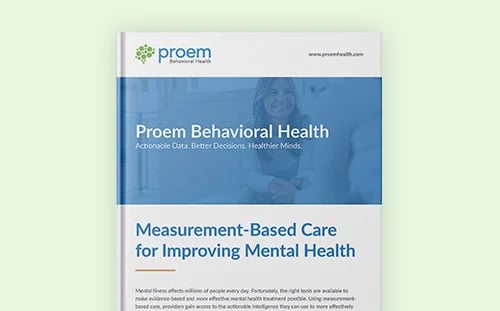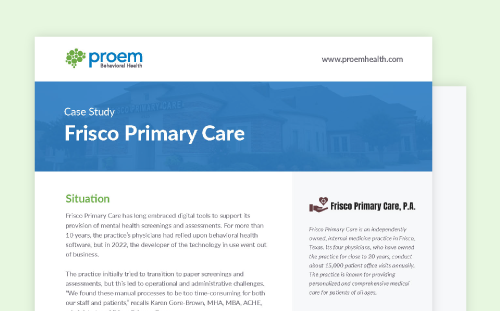
National Depression Screening Day takes place this year on October 7. This annual day of recognition is intended to call attention to the illnesses of depression on a national level to help educate the public about symptoms of depression and effective treatments. National Depression Screening Day falls during Mental Illness Awareness Week (October 3–9) and National Depression and Health Screening Month.
In this Q&A, Dr. Thomas Young, an expert in depression screening, speaks about the importance of depression screening, national shortcomings, and opportunities for improvement. The founder and chief medical officer of nView Health, Dr. Young is a board-certified family physician with more than 35 years of medical experience. He is a recognized thought leader in the fields of consumer-directed healthcare and population healthcare management and can often be found speaking on behavioral health podcasts and at industry events.
Q: Why is depression screening essential to health?

Dr. Thomas Young (TY): It's important to understand that mental health and physical health go together. The most common mental health disorder we see is depression. Finding depression early and addressing it improves people's outlook, productivity, and physical health. In addition, screening for depression ultimately reduces the cost of care in the healthcare system. All those reasons make depression screening essential.
Q: Where are we as a country coming up short in this area?
TY: Across the board. The U.S. Preventive Services Task Force says screening for depression and anxiety should begin by at least age 12. We're not just failing to consistently perform depression screening. We come up short in this country in most areas of preventive care.
One reason why is that preventive care and care at the primary care level are not reimbursed well enough to facilitate the delivery of that care. Reimbursement and payer situations all affect whether depression screening will be put into the average healthcare provider's workflow.
The other reason we're coming up short with depression screening is the classic question that a doctor asks: "So, I screen for these people, and I find them. What am I going to do with them?" In this country, we've had such a poor focus on mental health disorders. Not only are we confronted with access challenges, but also availability challenges. Those are two separate issues. This really became paramount during the pandemic when we opened up telehealth. Suddenly, more people had access to therapists, mental health providers, and peer support, which is great, but then we really saw that we didn't have the availability. There are not enough providers to meet the need and demand.
Q: What can be done to better ensure individuals who would benefit from depression screening are receiving the screening?
TY: It's a combined process of making the healthcare system understand that mental health and physical health are one. They're not separate. If I'm a provider, I must involve mental health in my physical care of patients. I need to make that a central part of what I do. Then, I need to have places where my patients can get the assistance that they need.
Q: Is depression screening on its own enough to help individuals?
TY: While one in five Americans have depression, as it's typically defined, depression is really a set of symptoms. Depressive symptoms occur in many mental health diseases. It becomes imperative to identify those diseases so they can be treated appropriately.
I liken depression to physical pain. Lots of things cause physical pain, like a broken leg, nerve disorder, or headache. But the treatment depends upon the cause of the physical pain. The same thing is true for depression. Depression is a symptom. It is not a diagnosis unless it's a diagnosis of major depressive disorder.
Since depression's set of symptoms occur in multiple mental health disorders, you must be able to differentiate those to treat them appropriately. You would not treat the pain of a broken leg the same way you would treat the pain of a headache. The same is true here: You would not treat the depression of bipolar disease the same way you would treat the depression of posttraumatic stress disorder. It becomes necessary to differentiate those diseases and disorders.
Q: What role can and should technology play in this effort?
TY: Technology has a huge opportunity to make screening more accessible and accurate through the use of more appropriate tools. For the past 25 years, we've essentially had the same tools. There had been little or no progress in this area but that's starting to change.
Technology can help provide solutions to care. There are many things coming online technologically that can provide a certain level of care for people with certain forms of depressive disorder and certain levels of severity of depression. Digital therapy, if you will, is here, and there are options to deliver it. There are a number of companies that have been doing this for a while without people realizing how effective they can be. One company had a study that demonstrated using computer-based cognitive behavioral therapy to treat people with mild-to-moderate depressive disorders was far better at delivering better outcomes than people going to face-to-face therapy.
Not only were there outcomes benefits in the study, but the care was delivered at a substantially reduced cost. You begin to solve two major problems with technology: You take the pressure off the number of people available to provide mental healthcare and you also reduce costs.

Watch nView's MENTAL HEALTHCARE TODAY podcast:
Tech and Screening. How important it is for patients and healthcare providers?





.png)
%20(2).png)





